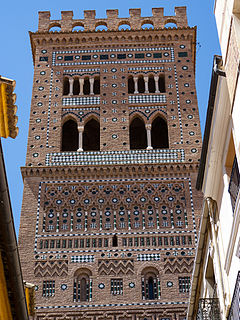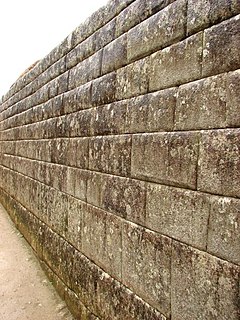
Teruel is a city in Aragon, located in eastern Spain, and is also the capital of Teruel Province. It has a population of 35,675 in 2014 making it the least populated provincial capital in the country. It is noted for its harsh climate, with a very big daily variation on temperatures and its renowned jamón serrano, its pottery, its surrounding archaeological sites, rock outcrops containing some of the oldest dinosaur remains of the Iberian Peninsula, and its famous events: La Vaquilla del Ángel during the weekend closest to 10 July and "Bodas de Isabel de Segura" around the third weekend of February.
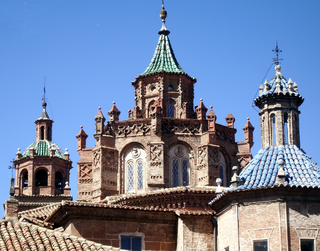
Mudéjar Architecture of Aragon is an aesthetic trend in the Mudéjar style, which is centered in Aragon (Spain) and has been recognized in some representative buildings as a World Heritage Site by UNESCO.

The Iglesia de San Román is a church in Toledo. The church was built in the Mudéjar style in the 13th century. In this site there was an old Visigothic structure and probably an ancient Roman building. It is currently the headquarters of the Museum of the Councils and Visigothic Culture.

Teruel Cathedral or Catedral de Santa María de Mediavilla de Teruel is a Roman Catholic church in Teruel. Dedicated to St. Mary, it is a notable example of Mudéjar architecture. Together with other churches in the town and in the province of Zaragoza, it has been listed as a UNESCO World Heritage Site since 1986.

The Torre de San Martín is a medieval structure in Teruel, Aragon, northern Spain. Built in Aragonese Mudéjar style in 1316 and renovated in the 16th century, it was added to the UNESCO Heritage List in 1986 together with other Mudéjar structures in Teruel.
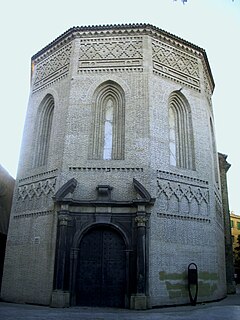
Santa María Magdalena is a church in Zaragoza, Spain, built in the 14th century in Mudéjar style.

The Tower of Iglesia de San Salvador is a mudéjar bell tower located in Teruel, Spain.

The Iglesia de Santo Tomé is a church located in the historical center of the city of Toledo (Spain), and was founded after the reconquest of this city by King Alfonso VI of León. It appears quoted in the 12th century, as constructed on the site of an old mosque of the 11th century. This mosque, together with other mosques in the city, were used as Christian churches without major changes, since in the taking of the city there was no destruction of buildings.

San Pedro Church is a 14th-century church and 13th century bell tower in Teruel, located in the Province of Teruel in the Aragon region of northeastern Spain.

The Convento de San Clemente is a Renaissance convent located in the city of Toledo, in Castile-La Mancha, Spain. It was founded in the 13th century during the reign of Alfonso X of Castile the Wise. Inside the building there are a Roman cistern, Mudéjar architecture, remains of the Palacio de los Cervatos and many decorative elements. It was rebuilt by Alonso de Covarrubias, and a cloister by José Ortega.

The Iglesia de las Santas Justa y Rufina is one of the so-called Mozarabic parish churches of Toledo, whose existence has been documented since 1156. However, certain material remains reveal the existence in this place of an Islamic construction, which would undoubtedly have to be identified with a mosque. Until very recently, the only testimony of the existence of an Islamic construction consisted of a fragment of arch that, on a Visigothic pilaster, was embedded in the northwest facade of the temple. The reuse of a piece from previous period, combined with the characteristics of the cutting of the arch, allow them to think of an Islamic work dating around 10th century.

The Iglesia de San Miguel el Alto is a Mudéjar church located in Toledo. It is one of the old Latin parishes of the city of Toledo. Apparently, this church was in relation to the Knights Templar being founded by them, serving as chapel or oratory of the inn for the knights of this order.
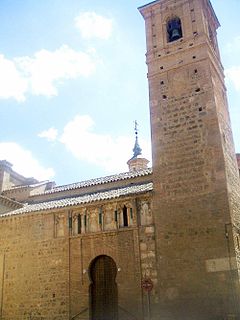
The iglesia de San Andrés is a church located in the city of Toledo, in Castile-La Mancha, Spain. The iglesia de San Andrés, as is common in this city, is a mix of different styles. On the one hand, there are present Mudéjar and Gothic architecture, and also, the Baroque, following a remodeling of the 17th century. After the last restoration traceries appeared in the facade that evoke the eclecticism of the crossing. A Visigoth relief and two Visigothic pilasters was also discovered.
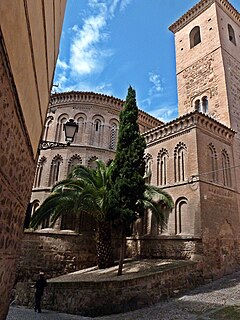
The Iglesia de San Bartolomé is a church located in the city of Toledo, in Castile-La Mancha, Spain.

The Iglesia de Santa Leocadia is a church located in Toledo, in Castile-La Mancha, Spain. The Toledan tradition maintains that this church is built on the site of the house where Saint Leocadia of Toledo was born, to which would belong a small underground room, where it is affirmed that it made prayer. This cave corresponds to the crypt located next to the right pillar of the presbytery, and is covered with a plaster crossery vault, which can be dated in the first half of the 16th century. In the tower and in the facade of the church are preserved, embedded, some fragments of Visigothic style's reliefs.

The Iglesia de los Santos Justo y Pastor, popularly known as Iglesia de San Justo, is a church located in the city of Toledo. It was founded after the city was taken by King Alfonso VI of León and Castile in the 13th century. The city underwent transformations between the 14th and 18th centuries. This is a religious temple under the invocation of the holy children Justus and Pastor.

The church of San Marcos in Toledo is a Mozarabic parish church, was formerly the church of a convent of the Trinitarios Calzados order. It was rebuilt in the 17th century.

The Palace of Fuensalida, is a palace located in city of Toledo built at the end of the first half of the 15th century by Pedro López de Ayala, the first lord of Fuensalida, is a great example of the Toledan Mudéjar, a historical typology that is scarce in Toledo built heritage, where merge three styles: Gothic, Plateresque and Mudéjar.

